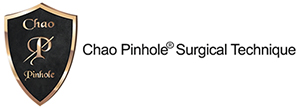Chao Pinhole® Gum Therapy
A Breakthrough Treatment for Gum Recession

What is gum recession?
Gum recession refers to the loss of gum tissue along the gum line. This can occur as a result of periodontal disease (gingivitis, periodontitis, advanced periodontitis), the natural aging process, or abrasive habits when it comes to brushing the teeth.
Why should gum recession be taken seriously?
When gum recession occurs, the root structure of the tooth becomes exposed. This means that tooth decay and other problems can affect the teeth along the gum line and beneath it. Since healthy gums are essential for a healthy mouth, getting gum recession treated is important for lasting dental wellness.
What is the Chao Pinhole Surgical Technique (PST)?
The Chao Pinhole Surgical Technique is a minimally invasive option for treating gum recession. Unlike traditional grafting techniques, PST is incision and suture free.
All of the tools and techniques used to perform the Chao Pinhole Surgical Technique were created by Dr. John Chao, and who trained our doctor.
How does the Chao Pinhole Surgical Technique differ from traditional gum grafting?
Traditional gum recession treatments involve the use of donor tissue or soft-tissue grafts in order to rebuild the gum line. This soft tissue would be sutured in place and would join with existing gum tissue as it healed.
While this traditional grafting treatment is effective, comparable results with better patient experience can be achieved through the Chao Pinhole Surgical Technique.
How is Chao Pinhole Surgical Technique performed?
During the Chao Pinhole Surgical Technique, a needle is used to make a small hole in the patient’s existing gum tissue. Through this pinhole, special instruments are used to gently loosen the gum tissue.
These tools help expand and slide the gum line to cover the exposed root structure.
There are no grafts, no sutures, and no incisions needed with the Chao Pinhole Surgical Technique. It simply involves the adjustment of the existing tissue.
What are the benefits of Chao Pinhole Surgical Technique?
The benefits of the Chao Pinhole Surgical Technique are many:
- Less discomfort for the patient after treatment
- Faster recovery for the patient than traditional grafting
- No need for uncomfortable sutures
- No need for scalpels or invasive surgical tools
- No need to take donor tissue from the patient’s palate
- Excellent, natural-looking, long-lasting results
Gum Tissue Grafting
When you come to our office for your grafting procedure, a local anesthetic will be given to numb the areas involved. You may also receive medicine to help you relax. We want your experience in our office to be as comfortable as possible, so let us know if there is anything you need during your procedure.
Depending on your specific needs, your dentist will perform one of three different types of gum tissue grafts.
- Connective tissue grafts: The most common method to treat root exposure, connective tissue grafting involves your dentist cutting a flap of skin on the roof of your mouth (or palate) and removing tissue from under the flap, called sub-epithelial connective tissue. This tissue is then stitched to the gum tissue surrounding the exposed root. After the connective tissue, or graft, has been removed from under the flap, the flap is then stitched back down.
- Free gingival grafts: Similar to a connective tissue grafting, a free gingival graft involves the use of tissue from the roof of the mouth. But instead of making a flap and removing tissue under the top layer of flesh, a small amount of tissue is removed directly from the roof of the mouth and then attached to the gum area being treated. This method is used most often in people who have thin gums to begin with and need additional tissue to enlarge the gums.
- Pedicle grafts: In this procedure, instead of taking tissue from the palate, it is grafted from gum around or near the tooth needing repair. The flap, called a pedicle, is only partially cut away so that one edge remains attached. The gum is then pulled over or down to cover the exposed root and sewn into place. This procedure can only be done if you have plenty of gum tissue near the tooth.
Copyright © John Chao DDS MAGD




